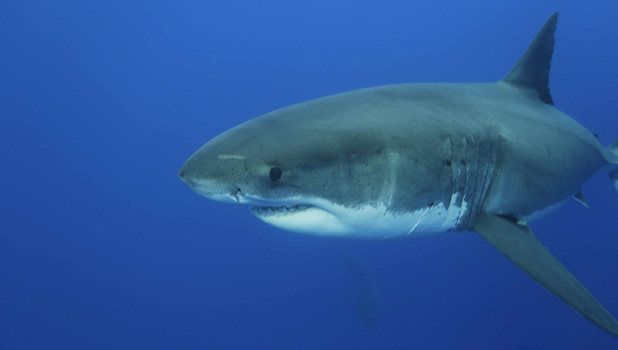As an open-water swimmer, I frequently encounter wildlife in the Bay and open ocean. My workouts normally take place in Aquatic Park with the San Francisco Swimming and Rowing Club, but my friends and I often take longer swims across the Bay and in the ocean.

White sharks have been seen in local waters in late summer and fall months, peaking in October. Photo ęDavid McGuire SharkStewards.org
By David McGuire
Published: October, 2016
As an open-water swimmer, I frequently encounter wildlife in the Bay and open ocean. My workouts normally take place in Aquatic Park with the San Francisco Swimming and Rowing Club, but my friends and I often take longer swims across the Bay and in the ocean.
Occasionally we encounter sharks, but most often it’s the wind, tides and angry sea lions that make me nervous. Thanks to efforts of organizations like Baykeeper, Save the Bay and to some degree our own (Shark Stewards), the San Francisco Bay is becoming healthier and the wildlife more abundant. Herring spawns bring in foraging seabirds and fish and provide nourishment for the harbor seals and harbor porpoises that frequent the Bay.
Inserted into this food web are the predators, including the sharks. White sharks enter the Bay in the late summer and fall months, with coastal observations peaking in October—the month we call Sharktober. The juvenile great white shark caught on a viral iPhone video last year consuming a seal near Alcatraz gained a lot of attention in the news and among my fellow Bay swimmers, but most sharks rarely make the news.
Around 11 species of sharks inhabit the Bay or use it as a feeding or breeding ground, with another 15 or so living outside in the waters of the Greater Farallones National Marine Sanctuary. These include the lovely leopard shark, a beautifully patterned houndshark that grows to six feet. This is the most common shark in the Bay, giving birth to live pups in the shallow parts of the estuary that have healthy eelgrass beds and wetland habitat.
Their close cousins, the brown smoothound and soupfin sharks, also mate and give birth to their live young in the Bay. Many of these sharks range along the outer coastline, but are also observed in the Bay’s deeper reaches.
Another shark seen in the Bay, commonly confused with the great white shark, is the salmon shark. These sleek, dark sharks are occasionally seen along the waterfront along Ocean Beach, and inside the Bay. These sharks can make acrobatic leaps out of the water in pursuit of their favorite prey (salmon) and can sometimes be observed during a ferry passage across the Bay. In the past few years, thresher sharks, normally an open water species, have also been observed leaping clear of Bay waters.
Ordinarily a deeper water species, the spiny dogfish swims on the bottom of the Bay in deeper waters and is a favorite food for sevengill sharks. In fact, the Bay is one of the primary nursery grounds for broadnose sevengill sharks along the California coast. Females enter in early summer and pup in shallow regions of the Bay including off Alameda and Hunters Point, where anglers frequently target them.
Rays are another member of the scientific grouping Elasmobranchii, which includes sharks, skates and rays. These “flat sharks” breed, forage and give birth in the muddy waters that play such an important role in the bottom ecosystem—which includes mud, sand and eelgrass beds. Bat rays are the most common in the Bay and popular among pier fisherman, who call them “mud marlin” for their fighting ability. The largest bat ray caught in the Bay measured nearly 11 feet in length and weighed 464 pounds!
Like the leopard sharks and smooth hounds, these fish forage on mollusks like clams as well as octopus, crustaceans and small fish. Other cousins include the big and longnosed skates, seldom seen and generally not targeted by anglers, yet important for maintaining the health of the bottom in a process called bioturbation. Another type of ray is the shovelnose guitarfish, which represents something of a transition between a shark and a ray.
Swimming across the Bay can be a wild experience, but most of the excitement passes unseen beneath our hands and our keels, and the importance of sharks is also unregarded. The San Francisco estuary provides critical habitat for these important fish, and sharks play a critical role in the health and balance of marine ecosystems. Many species of sharks are threatened with extinction, and the history of commercial shark fishing played its own role in reducing local shark populations. Increasing protection and habitat protection and providing best fisheries management practices are necessary to help ensure their survival and the health of the Bay.
This Sharktober, Shark Stewards is swimming for and celebrating sharks with a series of educational and fun events to help save sharks. Learn more at www.sharktoberfest.org.

